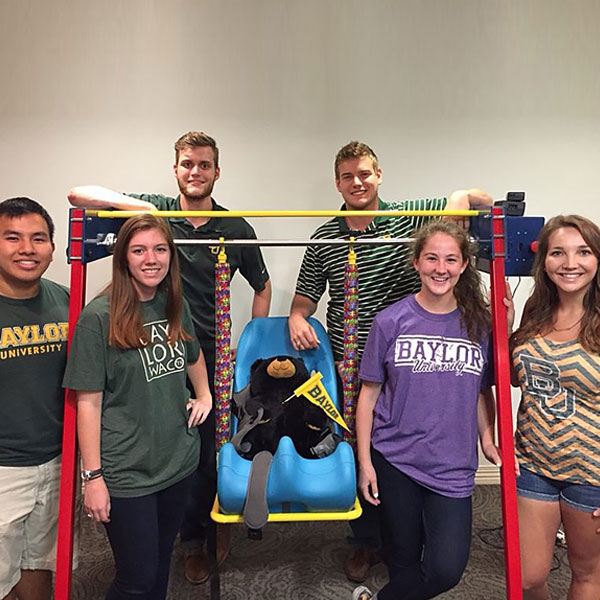Collaboration Leads to Swings and Wheels
This could be the story of a series of most fortunate events - with a tip of the hat to Lemony Snicket's A Series of Unfortunate Events.
Chapter 1
In brief, a conversation more than four years ago led to Baylor nursing and engineering students presenting a therapeutic swing to the Ronald McDonald House of Dallas (RMHD) in May. The gift to RMHD begins with a child named Camille.
Her father, Jason Whitt, BA ’96, PhD ’08, associate director of Baylor’s Institute for Faith and Learning (IFL), had a conversation with colleagues in the Baylor School of Engineering and Computer Science (ECS). Whitt explained that his special-needs daughter loved the soothing rocking motion found in infant safety swings; however, Camille had outgrown them.
ECS professors saw an opportunity to help. From there, teams of engineering students set about to build something special for Camille through their ECS senior capstone design projects. It took three teams working over three semesters—covering design, safety and construction—to deliver a motorized swing for then 7-year-old Camille. [Visit the Baylor Proud archives at baylor.edu/baylorproud for Camille’s Big Girl Swing, June 3, 2016, or the Spring/Summer 2016 issue of Baylor Magazine at baylor.edu/magazine for more of this story.]
Chapter 2
After learning of Camille’s swing, students in Baylor’s Louise Herrington School of Nursing (LHSON) recognized that the custom project was important for Camille because the gentle rhythm could improve her brain equilibrium and inspire connections with her surroundings.
The Baylor Student Nurses Association (BSNA) thought of children at the RMHD and reached out to engineering capstone students to ask for a similar swing for children who stay at RMHD. “Swing ’em, Bears” became the 2017 engineering capstone project.
“The senior design team met with the nursing school contributors of the project at RMHD in January. We discussed design ideas and brainstormed functionalities that we thought were important for the swing,” said Taylor McCants, an engineering team member who received a BS in electrical and computer engineering in May.
The collaboration extended beyond the initial brainstorming session as a nursing school representative attended each of the design team’s presentations about the swing.
Kaitlyn Po, BSNA president who received a BSN in May, said they were excited to work with their engineering “colleagues at Baylor to bring a swing to the Ronald McDonald House. BSNA has a long tradition of helping the RMHD and we wanted to do something special for those children and their families.”
Improvements to the swing presented to RMHD in May included the ability for it to be easily adjusted and moved by two people. Also, the swing’s angle can be adjusted (up to 45 degrees) to get a better swinging sensation, and the power source is a standard wall outlet.
Chapter 3
Beyond the two swings, the projects of several ECS senior capstone design teams have goals to ultimately help others. Another team worked on providing wheels for a child who wants to explore her environment and interact with other children.
Emmeline Pope, 2, has Spinal Muscular Atrophy (SMA), a neuromuscular disorder that impairs movement and can be fatal. Mobility devices are expensive, insurance coverage can be complicated, and child-sized devices are almost nonexistent.
A team of seven ECS students began work on the device in January, and they delivered wheels for Emmeline in early June. The students had to balance function and a tight budget (less than $1,000 which was provided by external sources).
They collaborated to develop a mobility system that was child-sized, operated easily with precision control, maneuverable over different floor types, and moveable into and out of the family’s vehicle. The students also wanted the device to have a child-friendly design and to aid interaction with other children.
The Pope family hopes Emmeline’s Child Mobility Aid will lead to help for other children.
For the ECS teams that have worked on the swings and wheels, it was a collision of real-world experience, Baylor’s Christian mission and directly improving someone’s quality of life.
“When we offer projects like [Emmeline’s Child Mobility Aid and Camille’s Swing], there’s a strong pull from a cross-section of students,” said Joe Donndelinger, clinical professor of professional practice and a faculty mentor for Emmeline’s team “These projects appeal to [the students] intrinsic motivation.”
Conversations and collaborations. The next chapter is yet to be written.
